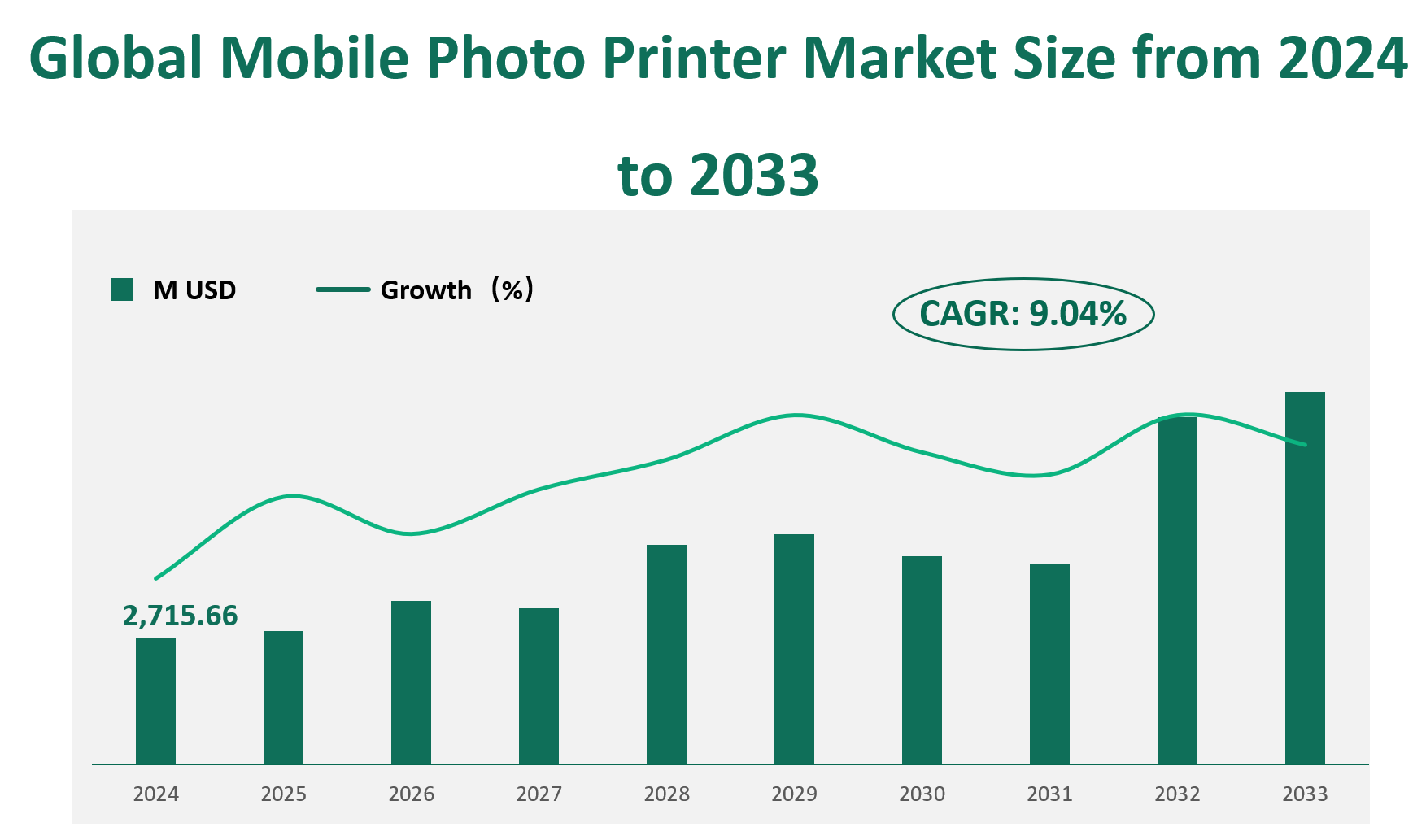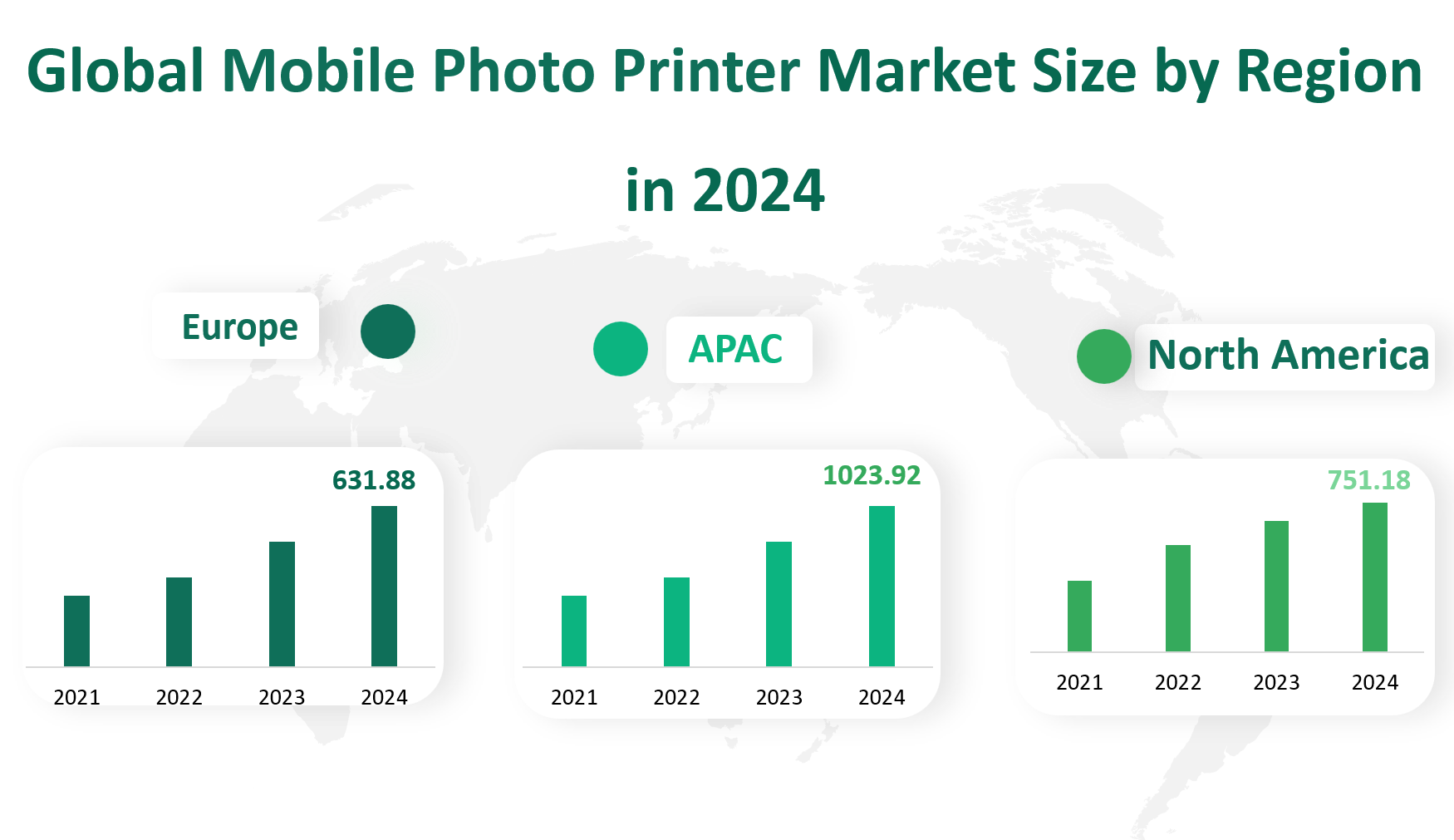1. Global Mobile Photo Printer Market Insight Analysis
The global Mobile Photo Printer market is projected to reach a value of $2,715.66 million in 2024, with a Compound Annual Growth Rate (CAGR) of 9.04% from 2024 to 2033.
A Mobile Photo Printer is a device that allows users to print photos directly from their mobile devices, such as smartphones and tablets. This technology has revolutionized the way people share and preserve their memories, offering a convenient and efficient alternative to traditional photo printing methods. Mobile Photo Printers use various printing technologies, including dye-sublimation, ZINK, instant film systems, and inkjet printing. These devices can connect to mobile devices via Wi-Fi, Bluetooth, or direct USB connections, enabling users to print high-quality photos on-the-go.
The market for Mobile Photo Printers has evolved significantly since its inception. Initially, these devices were primarily used by professional photographers and businesses. However, with the advent of affordable and user-friendly models, the market has expanded to include individual consumers who seek to print photos for personal use. The increasing popularity of social media and the rise in digital photo consumption have further fueled the demand for Mobile Photo Printers. These devices not only provide instant gratification but also offer a tangible way to share and display memories.
Figure Global Mobile Photo Printer Market Size (M USD) and CAGR (2024-2033)

2. Driving and Limiting Factors of Mobile Photo Printer Market Growth
The growth of the Mobile Photo Printer market is driven by several key factors. Firstly, the increasing adoption of smartphones and tablets has created a large user base that can benefit from mobile printing solutions. The convenience of printing photos directly from mobile devices has made Mobile Photo Printers an attractive option for both individuals and businesses. Additionally, the rise in social media usage has led to a surge in photo sharing, driving the demand for instant printing options.
Another significant driver is the technological advancements in printing technologies. Innovations in dye-sublimation, ZINK, and inkjet printing have improved the quality and speed of mobile photo printing. These advancements have made it possible to produce high-resolution, durable prints that can be used for various applications, from personal albums to commercial purposes.
Furthermore, the increasing awareness of eco-friendly practices has led to the development of more sustainable printing solutions. Many Mobile Photo Printers now use inkless or low-ink technologies, reducing the environmental impact of printing. This shift towards sustainability has resonated with consumers who are increasingly conscious of their ecological footprint.
One of the primary limiting factors is the high initial cost of some advanced printing technologies. While the prices of Mobile Photo Printers have decreased over the years, high-end models with advanced features can still be expensive for average consumers. This cost barrier may limit the market penetration, especially in developing regions.
Another challenge is the competition from alternative printing solutions. Traditional desktop printers and online photo printing services continue to dominate the market, offering cost-effective and convenient options for consumers. Additionally, the rapid evolution of digital photo storage and sharing platforms has reduced the perceived need for physical prints, further complicating the market dynamics.
Moreover, the market faces technical barriers, such as compatibility issues between different mobile devices and printers. Ensuring seamless connectivity and compatibility across various operating systems and devices remains a challenge for manufacturers. This can lead to user frustration and limit the adoption of Mobile Photo Printers.
3. Technology Innovation and Corporate Mergers and Acquisitions in Mobile Photo Printer Market
The Mobile Photo Printer market has witnessed significant technological innovations over the past few years. One notable trend is the integration of augmented reality (AR) and other advanced features into mobile printing solutions. For example, some printers now allow users to embed videos or interactive elements into their printed photos, enhancing the user experience.
Corporate mergers and acquisitions have also played a crucial role in shaping the market landscape. Major players in the industry, such as Canon and HP, have engaged in strategic acquisitions to expand their product portfolios and enhance their technological capabilities. For instance, Canon’s acquisition of BriefCam in 2018 aimed to strengthen its network video solutions business, incorporating advanced video content analysis technology into its product offerings.
Additionally, startups and emerging companies have introduced innovative solutions that have disrupted the traditional market dynamics. Companies like Prynt and Lifeprint have developed unique mobile printing solutions that combine hardware and software to offer novel user experiences. These innovations have not only attracted consumer attention but have also prompted established players to invest in research and development to stay competitive.
4. Global Mobile Photo Printer Market Size by Type
The mobile photo printer market is segmented into four primary product types: dye-sublimation, ZINK, instant film system, and inkjet.
Dye-sublimation printers use heat to transfer dye onto materials such as plastic, cards, paper, or fabric. This technology is known for its high-quality prints and durability. In 2024, the market revenue for dye-sublimation printers reached $911.31 million USD, with a market share of 33.57%.
ZINK printers employ an inkless printing method that uses heat-sensitive paper to produce full-color prints. They are popular for their convenience and portability. In 2024, ZINK printers achieved a market revenue of $1,491.49 million USD, holding the largest market share at 54.88%.
Instant film system printers are similar to traditional instant cameras, producing physical photos immediately after capture. These printers are favored for their nostalgic appeal and ease of use. In 2024, the market revenue for instant film system printers was $229.38 million USD, with a market share of 8.45%.
Inkjet printing involves propelling droplets of ink onto paper or plastic substrates. It is a versatile and widely-used printing technology, though less common in mobile photo printers. In 2024, the market revenue for inkjet printers was $83.48 million USD, with a market share of 3.07%.
ZINK printers hold the largest market share at 54.88%, making them the most dominant product type in the mobile photo printer market.
Table Global Mobile Photo Printer Market Size by Type in 2024
Market Size (M USD) 2024 | |
Dye-sublimation | 911.31 |
ZINK | 1491.49 |
Instant film system | 229.38 |
Inkjet | 83.48 |
5. Global Mobile Photo Printer Market Size by Application
The mobile photo printer market serves two primary applications: individual and commercial use.
Individual use refers to the purchase of mobile photo printers by consumers for personal purposes, such as printing photos for albums, gifts, or personal collections. In 2024, the market value for individual use reached $2,114.43 million USD, accounting for 79.32% of the total market.
Commercial use involves the purchase of mobile photo printers by businesses for profit-making activities, such as print shops, offices, and event photography. In 2024, the market value for commercial use was $601.23 million USD, with a market share of 18.68%.
Table Global Mobile Photo Printer Market Size by Application in 2024
Application | Market Size (M USD) 2024 |
Individual | 2114.43 |
Commercial | 601.23 |
6. Global Mobile Photo Printer Market by Top Regions
North America remains a significant market for mobile photo printers, driven by high consumer demand and technological advancements. In 2024, the market value in North America reached $751.18 million USD.
Europe is another key market for mobile photo printers, characterized by a diverse range of consumer preferences and economic conditions. In 2024, the market value in Europe reached $631.88 million USD.
The Asia-Pacific region is the largest market for mobile photo printers, driven by rapid technological advancements, growing consumer demand, and expanding economies. In 2024, the market value in the Asia-Pacific region reached $1023.92 million USD, making it the biggest regional market by revenue. Key markets within this region include China, Japan, South Korea, Australia, and India, each experiencing significant growth.
South America is an emerging market for mobile photo printers, with significant potential for growth. In 2024, the market value in South America reached $172.61 million USD.
The Middle East and Africa region is also an emerging market for mobile photo printers, driven by increasing consumer demand and economic development. In 2024, the market value in the Middle East and Africa reached $136.07 million USD.
Figure Global Mobile Photo Printer Market Size by Region in 2024

7. Global Mobile Photo Printer Market Analysis by Major Players
7.1 Canon
Company Introduction and Business Overview:
Canon Inc. is a leading global provider of imaging and optical products. Established in 1937, Canon offers a wide range of products, including digital cameras, printers, and networked multifunction devices. The company is known for its innovative technologies and high-quality products, which cater to both consumer and professional markets.
Products Offered:
Inkjet Printers: Canon’s inkjet printers are designed for easy and convenient photo printing directly from smartphones and tablets. These printers offer high-resolution prints and low running costs.
Dye-Sublimation Printers: Canon’s dye-sublimation printers are ideal for producing high-quality, durable prints on various materials.
7.2 HP
Company Introduction and Business Overview:
HP Inc. is a multinational technology company that provides a wide range of imaging and printing systems. Established in 1939, HP offers products such as laser and inkjet printers, scanners, and copiers. The company is known for its innovative solutions and strong market presence.
Products Offered:
HP Sprocket Studio: This mobile photo printer allows users to print high-quality photos directly from their smartphones. It features a user-friendly interface and supports various paper sizes.
Inkjet Printers: HP’s inkjet printers are designed for both home and office use, offering fast printing speeds and high-resolution prints.
7.3 Fujifilm
Company Introduction and Business Overview:
Fujifilm Holdings Corporation is a leading provider of imaging and information solutions. Established in 1934, Fujifilm offers a wide range of products, including digital cameras, photofinishing products, and office equipment. The company is known for its innovative technologies and high-quality products.
Products Offered:
Instax Printers: Fujifilm’s Instax printers are popular for their instant photo printing capabilities. These printers offer high-resolution prints and are compatible with various mobile devices.
Dye-Sublimation Printers: Fujifilm’s dye-sublimation printers are designed for producing high-quality, durable prints on various materials.

